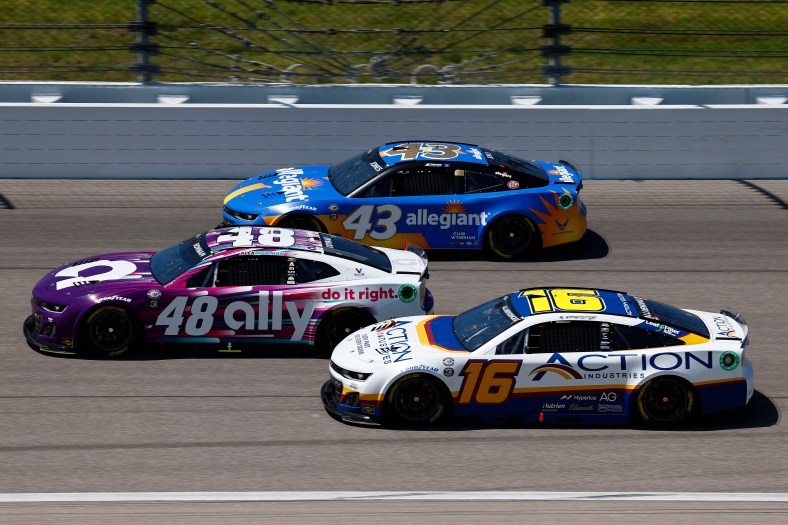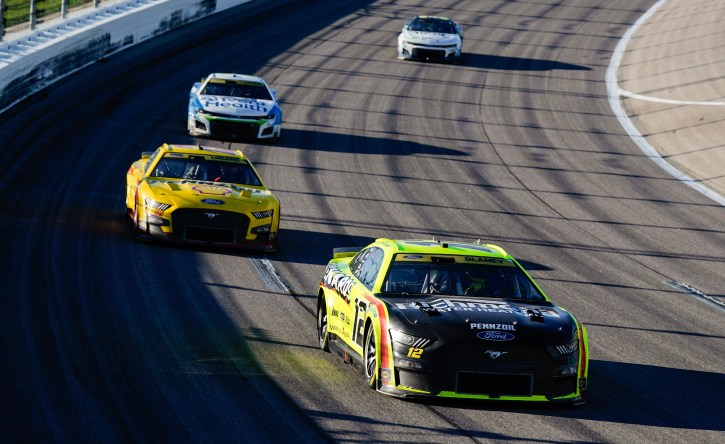
There remains a large majority of the NASCAR Cup Series garage that laments the decision to reconfigure Atlanta Motor Speedway into a diet superspeedway two years ago but Kansas Speedway is quickly becoming the alternative.
In many ways, the surface in Kansas City is starting to age into the D-shaped mile-and-a-half that everyone seems to have wanted Atlanta to remain forever. Unfortunately, the surface in Hampton, Georgia absolutely needed a repave but Speedway Motorsports also opted to reconfigure it into a drafting-style track.
With a surface that allows drivers to run against the wall to the apron equally, Ross Chastain says Kansas has become the best track of its kind, even if it’s not entirely the previous layout in Atlanta.
“I mean it’s way smoother so it’s totally different,” Chastain said. “I know that from a fan’s perspective and from my perspective 20 years ago as 10-year-old Ross, I couldn’t told you the difference because I was a very casual fan.”
With that said, the track has lost more and more grip every year and it has widened out considerably.
“It’s a ton of fun,” he said. “There are so many options. The only lane that I cannot run is the lane behind the car in front of me. So, that’s the only option I don’t give myself into the corner.”
Read More: Everything you need to know before Sunday’s race

Michael McDowell says the track has generated a lot more action in recent years because of the multiple options drivers have to attack the corners. Entry starts off wide but funnels into something narrower by the exit and that lends itself to contact.
“You’re always looking for clean air so on those restarts when the guy ahead of you goes high or the middle, you’re looking to go to whatever lane he leaves open but they’re also probably side-by-side ahead of you, so you end up in a three- or four-wide scenario,” McDowell said. “Everyone is trying to get track position and momentum so you get to the exit of the corner and everyone is jammed up and there’s not enough room or someone pushes up to the car on the outside and pushes them into the wall.
“There’s a decent amount of space at Kansas and grip in each lane so I do feel like this is what creates side-by-side racing each lap.”
In other words, Kansas, which was last repaved in 2012, has reached that sweet spot between losing enough grip that it widens out but still enough to stay side-by-side. That was certainly the case in the spring, a race that produced 37 lead changes and 11 cautions before Denny Hamlin emerged victorious.
That point was illustrated by Kevin Harvick.
“I think Kansas has been a great racetrack and, really, from a driver’s standpoint, a fun racetrack because of the fact that it’s worn in so well,” Harvick said. “You can race at the top of the racetrack, which is the preferred groove as the tires wear out. It’s faster at the bottom of the racetrack on new tires.
“But as a driver, having options is something that is a lot of fun. With Atlanta having been repaved along with some of the other racetracks, Kansas has become one of the more unique racetracks because of the fact the asphalt and the shape of the racetrack are so driver-friendly, as far as where you can drive on the racetrack. You can literally drive from the wall to the apron all the way around the racetrack. So, it’s a fun racetrack.”
“There’s plenty of places like Charlotte where you can go two-wide, three-wide but one lane will always prevail,” McDowell said. “At Kansas, it kind of seems like everyone kind of ends up at the same spot on exit, so it just kind of jams up.
“As the track has started to age, we’re close to the limit of the tire and the ability of the car. So, we’re having to take chances and we’re doing it at close quarters. A lot can happen or go wrong if we’re not careful.”
It’s no secret that the current generation NASCAR Cup Series car is more aerodynamically sensitive than its predecessors but the width of the track means drivers are less likely to get stuck in dirty air, too. For that reason, Kansas is a favorite of William Byron’s.
“It’s easier to pass,” Byron said. “If we lose our track position for whatever reason, we won’t get stuck back there. We have options.”
Read More: Denny Hamlin hopes to end his career with Joe Gibbs Racing
To his peers’ points, Blaney says everyone racing to get to the wall and trying to see who can run the closest to it is what creates so much passing and action.
“This place is unique,” Blaney said. “It’s not super old but the wall has become the quickest way around and the guys who can run right up against the wall are the ones who usually win. The last three winners here, Denny, Bubba and Kurt can run against the wall and can make time that way. It’s a lane to pass people. If you can run against the fence, you won’t get stuck behind someone.
“What’s made the races crazy competitive is that you have a leader who is fast but glued to the fence and then a guy running second, who is faster and can run off the wall but can still make a pass. For whatever reason, the bottom is kind of gone. I think it can come back but the racing is better when you can race against the wall.
“Certainly, it’s more exciting than a race where everyone is glued to the bottom, that’s for sure.”
Matt Weaver is a Motorsports Insider for Sportsnaut. Follow him on Twitter.